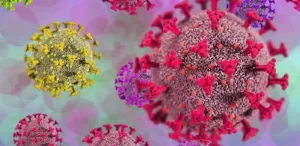Understanding COVID-19 Replication Sparks Innovative Antiviral Treatments

- Study reveals how SARS-CoV-2 utilizes lysosomes for replication, potentially paving the way for new antiviral therapies.
- Findings highlight the importance of understanding viral replication mechanisms beyond entry stage for developing effective treatments against COVID-19 and related viruses.
A new study, looking at the replication stage of the SARS-CoV-2 virus that causes COVID-19, discovered important mechanisms in its replication that could be the foundation for new antiviral therapies.
The study, which set out to investigate how the SARS-CoV-2 virus replicates once it enters the cells, has made surprising discoveries that could be the foundation for future antiviral therapies. It also has important theoretical implications as the replication of the SARS-CoV-2 virus has, so far, received less attention from researchers.
These findings show what an exquisite cell biologist the SARS-CoV-2 virus is, and shed new light onto how infection with SARS-CoV-2 can disrupt the function of essential intracellular compartments, otherwise known as organelles.
Dr Jeremy Carlton, Reader in Molecular and Cellular Biology
The viral life cycle can be broken down into two main stages: the first stage is where the virus enters the cell. The second stage is replication where the virus uses the molecular machinery of the cell it has infected to replicate itself by building its parts, assembling them into new viruses that can then exit to infect other cells.
The majority of research into SARS-CoV-2 – the causative agent of COVID-19 – has focused on the Spike protein that allows viral entry. This has led to a lack of understanding of how the virus replicates once it has entered the cell.
A new paper led by Dr Jeremy Carlton in collaboration with Dr David Bauer at the Francis Crick Institute, focuses on how the Envelope protein of SARS-CoV-2 controls late stages of viral replication.
Published in Science Advances, the authors marked the Envelope protein with fluorescent tags to track its movement within cells and used proteomics to identify key pathways that allow SARS-CoV-2 to take over the internal compartments of the infected cell – known as organelles – for its replication.
The authors identified a surprising aspect of its replication in its use of a compartment called the lysosome during viral release. Lysosomes are acidic, degradative organelles, but SARS-CoV-2 uses its Envelope protein as an ion-channel to neutralise their acidity and so enhance viral release.
As well as broadening our theoretical understanding of the viral life cycle, such insights on replication could eventually be applied to create new antiviral therapeutics that inhibit the channel activity of the Envelope protein. These could apply not only to SARS-CoV-2, but to the β-coronavirus family and any other virus that replicates with the same mechanisms.
The authors are now planning to look at other structural proteins in the SARS-CoV-2 virus, the membrane of the lysosome, and other components of the (infected) cell, to further understand how the virus replicates before its release.
Source: King’s College London















